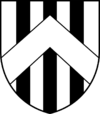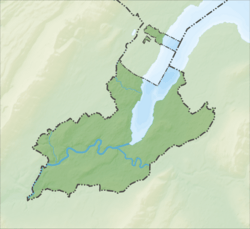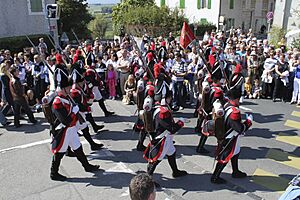Russin facts for kids
Quick facts for kids
Russin
|
||
|---|---|---|
 |
||
|
||
| Country | Switzerland | |
| Canton | Geneva | |
| District | n.a. | |
| Area | ||
| • Total | 4.91 km2 (1.90 sq mi) | |
| Elevation | 410 m (1,350 ft) | |
| Population
(Dec 2020 )
|
||
| • Total | 530 | |
| • Density | 107.9/km2 (279.6/sq mi) | |
| Postal code |
1281
|
|
| Surrounded by | Aire-la-Ville, Avully, Cartigny, Dardagny, Satigny | |
Russin is a small municipality located in the canton of Geneva in Switzerland. It is a quiet place known for its beautiful natural surroundings.
Contents
A Glimpse into Russin's Past
Russin is a town with a long history. It was first mentioned in old writings around the year 1100. Back then, it was called Russino or Rucins. Later, in 1217, its name appeared as Russins.
Exploring Russin's Geography
Russin covers an area of about 4.91 square kilometers (about 1.9 square miles). A large part of this land, more than half, is used for farming. About one-fifth of the area is covered by forests.
The town is located on the right bank of the Rhone river. Russin includes the main village and smaller areas called hamlets. These hamlets are Verbois, La Chaumaz, and Les Baillets. The municipality also has sub-sections like Molards and Teppes-du-Biolay.
Who Lives in Russin?
Russin has a population of 530. About 23.8% of the people living here are from other countries. Over the past ten years, the population has grown by about 16.6%.
Most people in Russin speak French. About 86.7% of the population uses French as their main language. Other languages spoken include German and Portuguese.
In 2008, a little more than half of the population was male (51.4%), and slightly less than half was female (48.6%). About 26.8% of the people living in Russin in 2000 were also born there.
Population Changes Over Time
The age groups in Russin show that about 25.5% of the population are children and teenagers (0–19 years old). Adults (20–64 years old) make up 62.2% of the population. Seniors (over 64 years old) make up 12.2%.
Most people in Russin are married. In 2000, there were 196 married individuals. There were also 160 single people who had never been married.
The chart below shows how Russin's population has changed over many years:

Important Heritage Sites
The Campagne De La Grand’Cour is a very important historical site in Russin. It is listed as a Swiss heritage site of national significance. This means it is a special place protected for its history and culture.
Russin's Economy and Jobs
In 2010, Russin had a low unemployment rate of 3.2%. This means most people who wanted jobs had them.
Many people in Russin work in different types of jobs:
- Primary Sector: This includes jobs like farming. About 32 people worked in this area in 2008.
- Secondary Sector: This includes jobs in manufacturing and construction. About 49 people worked in this sector.
- Tertiary Sector: This includes jobs in services, like sales, restaurants, and education. About 27 people worked in this sector.
Many people who live in Russin travel to other towns for work. In 2000, 15.2% of workers used public transportation to get to their jobs. A larger number, 53.4%, used a private car.
Religion in Russin
According to the 2000 census, many people in Russin belong to Christian churches. About 43.1% were part of the Swiss Reformed Church. Another 21.9% were Roman Catholic.
Some people belonged to other Christian churches. A small number of people were Muslim or Buddhist. About 23.47% of the population did not belong to any church.
Learning and Education in Russin
Education is important in Russin. About 33.9% of the population has finished upper secondary education. This is like high school. About 22.2% have gone on to higher education, such as university.
During the 2009-2010 school year, there were 85 students in Russin's school system. The Canton of Geneva has a school system that includes:
- Kindergarten: Young children can attend two years of non-mandatory kindergarten.
- Primary School: Students must attend six years of primary school.
- Secondary School: This program has three required years, followed by three to five years of optional advanced schooling.
In Russin, there were 16 students in kindergarten or primary school. There were also 16 students in lower secondary school. Many students from Russin also attend schools outside the municipality.
Getting Around Russin
Russin has its own railway station, called Russin. This station is on the Lyon–Geneva line. You can take a train from Russin to places like La Plaine, Bellegarde, and Geneva.
See also
 In Spanish: Russin para niños
In Spanish: Russin para niños







